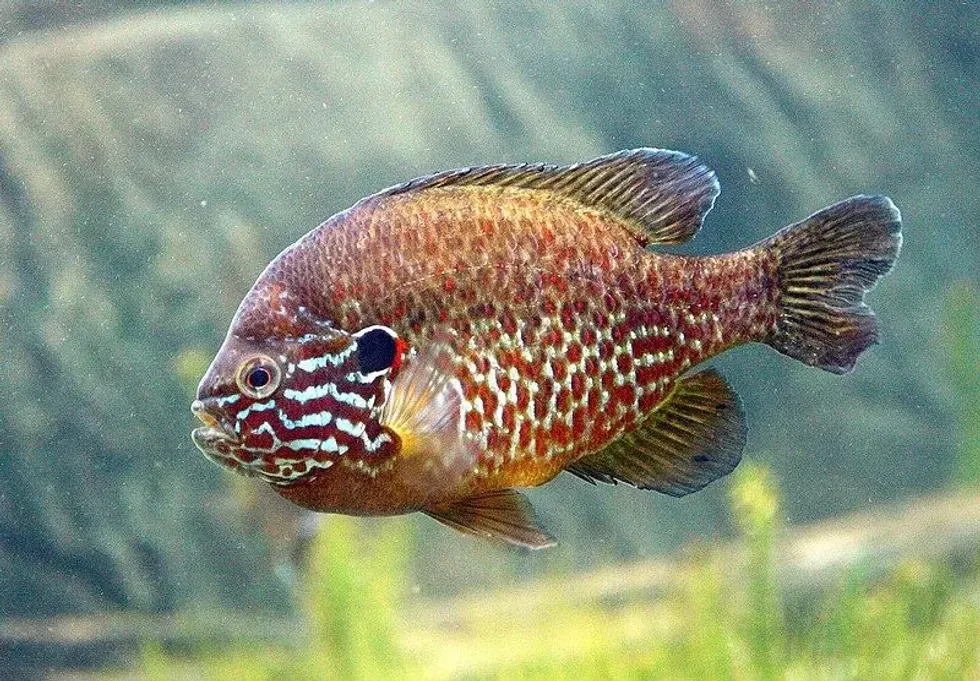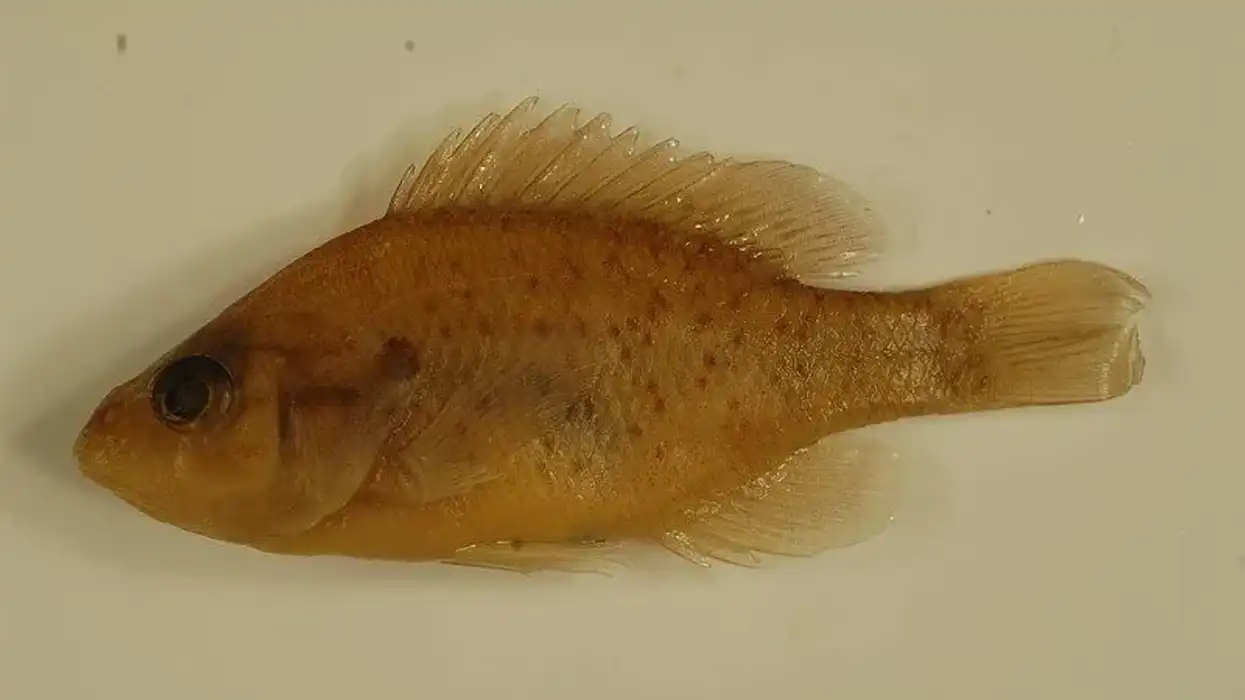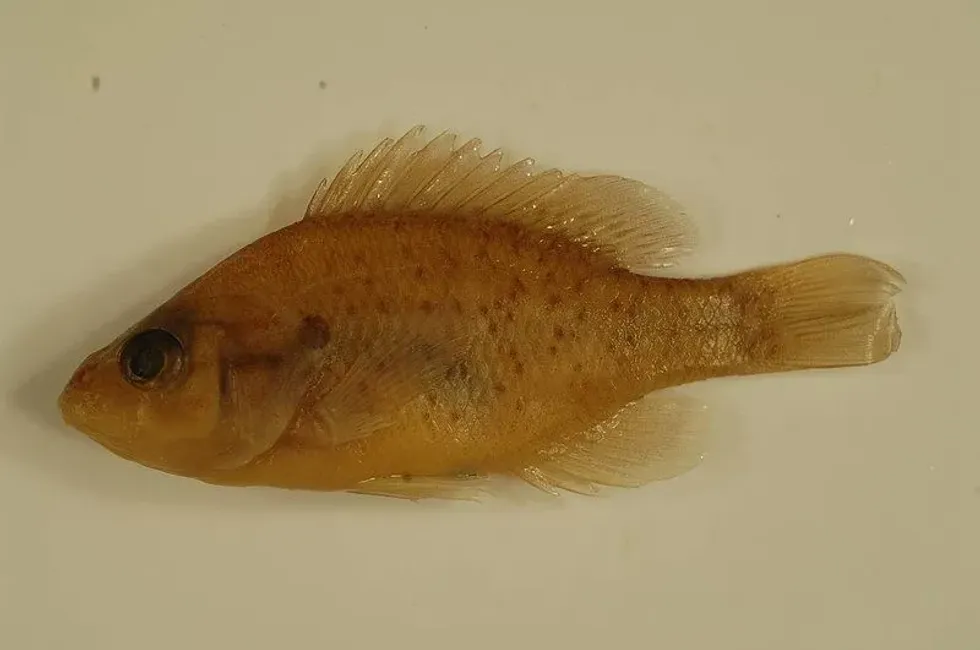Fun Orangespotted Sunfish Facts For Kids

Are you fascinated with colorful fishes like tang fish? If yes, then you will surely find the orangespotted sunfish (Lepomis humilis) quite interesting.
This tiny fish belongs to North America and is mostly found in floodplains of the United States of the Great Lakes. It is one of those freshwater fishes that can live in murky and fairly still water. Its beautiful shiny silvery-blue body has reddish-orange spots, which give it its name of being orangespotted.
This fish belongs to the Lepomis genus, which contains other sunfish species. The humilis, in its scientific name, means humble, which is quite apt for this tiny fish.
This fish mainly sustains itself on the insects and larvae found in its natural habitat. It is also known for clearing out mosquito larvae which definitely helps us in having a better environment.
One of the most interesting things about this species is its spawning practice. The males take care of the fish and keep fanning on it to keep it oxygenated.
Moreover, the male orangespotted fish is known for making a courting call for the females. The population of this fish is going strong, and it is protected in many areas. However, some of the populations are at threat due to human activities in their native habitat.
Isn't this fish fascinating? Keep reading to learn more orangespotted sunfish facts.
Are you fascinated with the world of animals? Then, do check out the articles on sawfish facts and goblin shark facts to know more about bigger fishes.
Orangespotted Sunfish Interesting Facts
What type of animal is an orangespotted sunfish?
The orangespotted sunfish (Lepomis humilis) is a species of sunfish native to North America.
What class of animal does an orangespotted sunfish belong to?
The orangespotted sunfish belongs to the class Actinopterygii and the genus Lepomis it shares with other sunfish species like spotted sunfish. Another popular fish in the Actinopterygii class is the tang fish.
How many orangespotted sunfishes are there in the world?
As an abundantly found fish, we cannot really know the exact population of this species. The IUCN notes that this fish does have a large population even though it is uncounted.
Where does an orangespotted sunfish live?
Orangespotted sunfish are freshwater fishes native to North America, mainly concentrated in the United States. It is mainly present in the southern half of the Great Lakes. The fishes have also been introduced to places like the Rio Grande Basin.
Texas is one of the states where these fishes are predominantly found in the ecology. It can be seen in areas of the Colorado River drainage, the Sabine Lake, and the Galveston Bay. The range is usually thought to be from the Great Lakes to Texas.
What is an orangespotted sunfish's habitat?
Largely, the orangespotted sunfish's habitat is in lakes, ponds, backwaters, streams, or barrow pits. It prefers to live in relatively quiet waters in places with silt or sand substrates.
This fish has a high tolerance to muddy and polluted water making it important in ecology where many insects are found. You can mainly find this fish in areas with fairly good vegetation. These freshwater fishes have a low tolerance to brackish water and can only tolerate a salinity level of 0.74 ppt.
The fishes do move towards shallower and quieter waters during spawning. It will definitely give priority to places where there is a high concentration of food.
Who does orangespotted sunfish live with?
Not a lot is known about the way the Lepomis humilis fishes live during the non-breeding season. However, these freshwater fishes are usually found in pairs during the spawning season and raise the young.
How long does an orangespotted sunfish live?
The average lifespan of the orangespotted sunfish is around three to seven years.
How do they reproduce?
Reproduction for these freshwater fishes mainly happens during the months of April to September. During the orangespotted sunfish spawning, these fishes produce one or two clutches depending on the geographical area. In a single spawning, the female fishes are able to lay up to 175-4700 eggs.
The male fishes make the nest by fanning on the substrate to create a suitable depression. These fishes move to more slow-flowing waters during this time to keep the eggs undisturbed. The male fishes produce a courtship call during breeding.
Interestingly, the orangespotted fish will often breed and nest in similar areas as the other Lepomis species, leading to hybridization. Topeka shiners is another nest associate that is commonly seen in the orangespotted habitat.
The water temperature is above 64.4°F (18°C) during the spawning season, and it mainly happens over gravel and rock substrates. Males are active in taking care of the eggs. The orangespotted sunfish larvae life cycle begins as the dad fans over the eggs to keep them oxygenated and clean until the hatching occurs.
When the temperatures are right, eggs hatch in just five days. The fishes reach sexual maturity by the second or third year of their existence.
What is their conservation status?
According to the International Union for Conservation of Nature (IUCN) Red List, the orangespotted sunfish is currently collected under the status of Least Concern. Even though the population of this fish is relatively stable, it is still at a threat because of the increased human activities.
Hence, the floodplain environment which forms the main habitat of these fishes needs to be managed.
A common problem has been reduced inundation of the floodplains due to extensive agricultural practices. As the fish can sustain in low oxygen areas, the population is still going strong.
In Canada, the natural areas of occurrence of the fish are under protection to let the species spawn with the most success. Sadly, fishing in areas where the orangespotted fishes dwell has had a bad toll on the species because of the use of plastic netting and electrofishing.
Orangespotted Sunfish Fun Facts
What do orangespotted sunfish look like?

*This picture is of the pumpkinseed sunfish (Lepomis gibbosus) that looks very similar to the orangespotted sunfish. If you have an image of an orangespotted sunfish, send us an email at hello@kidadl.com.
The most prominent thing about the orangespotted sunfish is its bright orange spots, giving it the iconic name. These orange spots are also the main identification of species, as its body looks similar to other sunfish species.
The fish's main body is silvery blue, and it may also appear black, and orange spots are present on it. In males, the spots tend to appear more orange, while it appears to be rusty red in females.
The gill flap or operculum is black with a white margin. Unlike other sunfishes, no blue-green lines are seen on the face of this fish, but faint reddish lines can be spotted.
A quick way to identify the males for the females is that the males get brighter during the spawning season. The dorsal fin is usually orange.
The juveniles look different from the adults and have no spots on the sides of its body. Instead, vertical lines are present on the body, and as it matures, the orange dots start to appear.
An interesting observation is that the females may turn almost black during spawning. When we look at the overall shape of the fish, it has a compressed or flattened look.
It has spiny fins and has three spines on the anal fin. Moreover, up to 13 spines are present in the dorsal fin along with around 11 dorsal rays.
How cute are they?
The orangespotted sunfish is a cute and adorable species that looks extremely attractive because of its small size. Its shiny silver color catches the sun's rays and makes the fish look quite attractive.
How do they communicate?
One of the striking forms of communication portrayed by the orangespotted sunfish is the courtship sound made during spawning. The males make the grunting sound while it goes to and fro in the nest to woo the mate.
As many sunfish species make a courtship sound, the females of the orangespotted species have got an ear to distinguish the male fishes from their own species. Other than this form of specialized communication, these fishes also communicate with the help of chemicals and gestures like other species.
How big is a orangespotted sunfish?
The average length of the orangespotted sunfish is around 1.5 in (3 cm). However, the fishes have been known to grow to the length of 5.9 in (15 cm). Compared to this species, its genus cousin, the pumpkinseed sunfish, grows to an average length of 4 in (10 cm). Both fish are similar in size.
How fast can an orangespotted sunfish swim?
We are yet to find out about the orangespotted sunfish range for swimming. As these fishes live in silted areas, it likes to have a slower pace and isn't a speedy swimmer.
How much does an orangespotted sunfish weigh?
As a tiny species, we do assume that these fishes would weigh a lot, but no conclusive data is available about the average weight of this species.
What are the male and female names of the species?
There are no distinct names for the males and females of this fish species.
What would you call a baby orangespotted sunfish?
A baby orangespotted sunfish can be called a fry, but many people like to refer to it as larvae because of its tiny size.
What do they eat?
The orangespotted sunfish is mainly an insectivorous fish; hence it relies on insect species that are present in its habitat. This consists of different insect larvae like mayfly larvae and chironomid larvae.
Other things that are part of its diet include midges and caddisfly. When kept in an aquarium, these fishes can be fed live food like bloodworms and shrimps. This fish species will also accept pre-packaged fish food that is usually available in pet stores.
Are they poisonous?
No, these aren't poisonous fishes.
Would they make a good pet?
Yes, the orangespotted sunfish can definitely become a great pet if you can take good care of it. This fish prefers silt or sand substrate in its aquarium.
It is quite easy to take care of this fish, and if you are present near its natural habitat, catching it is a piece of cake. This colorful freshwater fish also lives for a fairly long time, making it a good pet for children.
Did you know...
Lepomis humilis is one of the 13 recognized species present in the Lepomis genus.
Do they bite?
This fish is too small to have a big enough bite to harm a human being. Even if this fish species manages to get a hold of your skin, it would hardly feel like a bite. These fishes are too cute to be dangerous for human beings.
Do humans eat them?
No, humans do not consume these colorful fishes as it is relatively small. However, it is often caught by people as these are common in silted areas, and some people also keep it in aquariums.
Another ingenious way of using this fish is for curbing mosquito populations as the orangespotted sunfish like to eat the larvae, making it important for the ecology.
Here at Kidadl, we have carefully created lots of interesting family-friendly animal facts for everyone to discover! Learn more about some other fish including herring facts and catfish facts.
You can even occupy yourself at home by coloring in one of our free printable orangespotted sunfish coloring pages.
We Want Your Photos!
More for You
See All
Bachelor of Arts specializing in Journalism and Mass Communication, Postgraduate Diploma in Sports Management

Moumita DuttaBachelor of Arts specializing in Journalism and Mass Communication, Postgraduate Diploma in Sports Management
A content writer and editor with a passion for sports, Moumita has honed her skills in producing compelling match reports and stories about sporting heroes. She holds a degree in Journalism and Mass Communication from the Indian Institute of Social Welfare and Business Management, Calcutta University, alongside a postgraduate diploma in Sports Management.
Bachelor of Arts specializing in English Literature, Masters of Art specializing in English and Communication Skills

Sonali RawatBachelor of Arts specializing in English Literature, Masters of Art specializing in English and Communication Skills
Sonali has a Bachelor's degree in English literature from Guru Gobind Singh Indraprastha University and is currently pursuing a Master's in English and Communication from Christ University. With considerable experience in writing about lifestyle topics, including travel and health, she has a passion for Japanese culture, especially fashion, and anime, and has written on the subject before. Sonali has event managed a creative-writing festival and coordinated a student magazine at her university. Her favorite authors are Toni Morrison and Anita Desai.
Disclaimer
1) Kidadl is independent and to make our service free to you the reader we are supported by advertising. We hope you love our recommendations for products and services! What we suggest is selected independently by the Kidadl team. If you purchase using the Buy Now button we may earn a small commission. This does not influence our choices. Prices are correct and items are available at the time the article was published but we cannot guarantee that on the time of reading. Please note that Kidadl is a participant in the Amazon Services LLC Associates Program, an affiliate advertising program designed to provide a means for sites to earn advertising fees by advertising and linking to Amazon. We also link to other websites, but are not responsible for their content.
2) At Kidadl, we strive to recommend the very best activities and events. We will always aim to give you accurate information at the date of publication - however, information does change, so it’s important you do your own research, double-check and make the decision that is right for your family. We recognise that not all activities and ideas are appropriate for all children and families or in all circumstances. Our recommended activities are based on age but these are a guide. We recommend that these ideas are used as inspiration, that ideas are undertaken with appropriate adult supervision, and that each adult uses their own discretion and knowledge of their children to consider the safety and suitability. Kidadl cannot accept liability for the execution of these ideas, and parental supervision is advised at all times, as safety is paramount. Anyone using the information provided by Kidadl does so at their own risk and we can not accept liability if things go wrong.
3) Because we are an educational resource, we have quotes and facts about a range of historical and modern figures. We do not endorse the actions of or rhetoric of all the people included in these collections, but we think they are important for growing minds to learn about under the guidance of parents or guardians.







